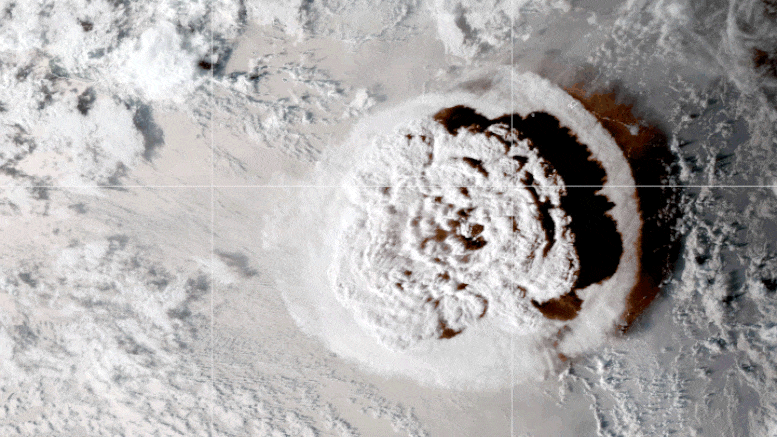
This looping video shows a series of GOES-17 satellite images that caught an umbrella cloud generated by the underwater eruption of the Hunga Tonga-Hunga Ha’apai volcano on January 15, 2022. Crescent-shaped bow shock waves and numerous lighting strikes are also visible. Credit: NASA Earth Observatory image by Joshua Stevens using GOES imagery courtesy of NOAA and NESDIS
The January 2022 eruption of the Hunga volcano in Tonga was the largest volcanic eruption in the 21st century, and the largest recorded since the 1991 eruption of Mount Pinatubo.
NASA determined that the eruption was “hundreds of times more powerful than the atomic bomb dropped on Hiroshima.”
New research by an international team of scientists from 17 countries including Lawrence Livermore National Laboratory (LLNL) scientist Keehoon Kim demonstrates that, based on atmospheric pressure waves recorded by global barometers, the Hunga explosion was comparable to the 1883 Krakatoa eruption in size. The research was published earlier this month in the journal Science.
The atmospheric wave data shows that the eruption propagated for four passages around the Earth over six days. NASA determined that the eruption was “hundreds of times more powerful than the atomic bomb dropped on Hiroshima.”
The eruption began in December 2021 on Hunga Tonga–Hunga Ha’apai, a submarine volcano in the Tongan archipelago in the southern Pacific Ocean (submarine volcanoes are underwater vents or fissures in the Earth’s surface from which magma can erupt). The final eruption in January caused tsunamis in Tonga, Fiji, American Samoa, Vanuatu, and along the Pacific rim, including damaging tsunamis in New Zealand, Japan, the United States, the Russian Far East, Chile, and Peru.
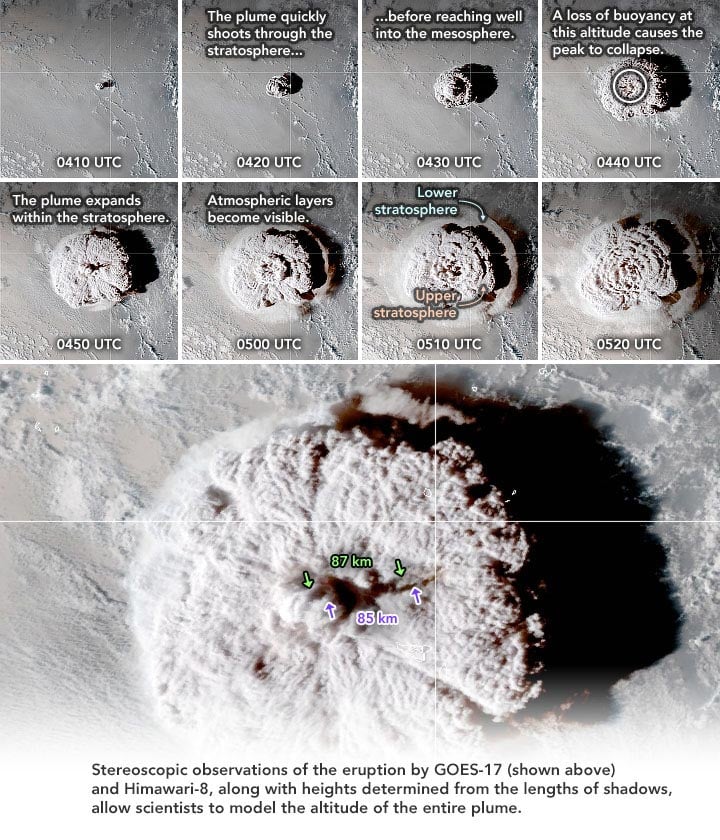
A NASA satellite captured the explosive eruption of Hunga Tonga–Hunga Ha‘apai in the South Pacific. Credit: Image by Joshua Stevens/NASA Earth Observatory, using GOES-17 imagery courtesy of National Oceanic and Atmospheric Administration and National Environmental Satellite, Data and Information Service
The 1883 eruption of Krakatoa began May 20, 1883, and peaked on the late morning of August 27, 1883, when more than 70% of the island of Krakatoa and its surrounding archipelago were destroyed as it collapsed into a caldera. The eruption killed more than 36,000 people, making it one of the most devastating volcanic eruptions in human history.
The new study indicates that the Hunga volcano produced an explosion in the atmosphere of a size that has not been documented in the modern geophysical record. The event generated a broad range of atmospheric waves observed globally by various ground-based and spaceborne instrumentation networks. The eruption from a submerged vent delivered volcanic ash and gas primarily into the stratosphere. An umbrella cloud developed at approximately 30 kilometers (~19 miles) above sea level, with a central transient overshoot much higher.
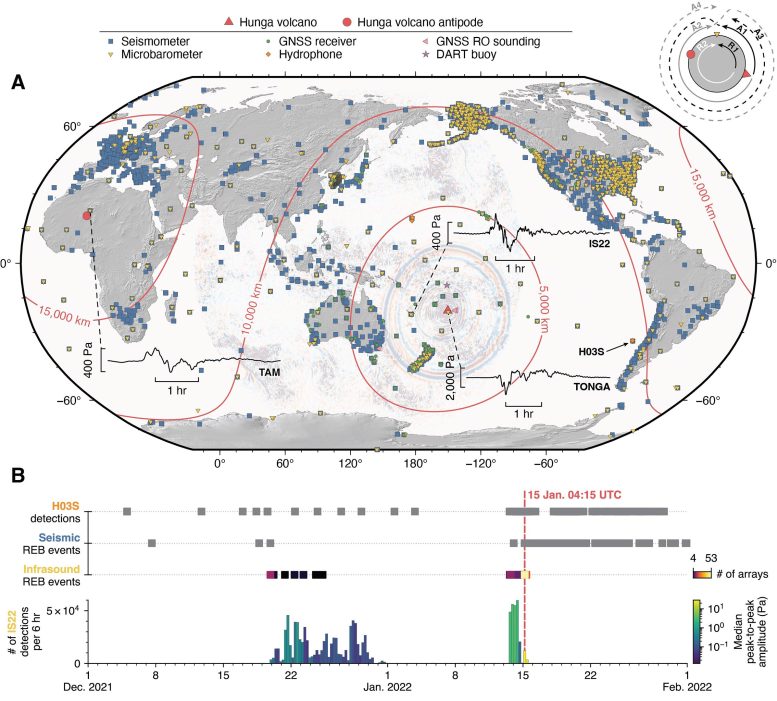
The top image shows the locations of instruments that provided data. Red-and-blue pattern around the Hunga volcano is a time snapshot image from a weather satellite showing the atmospheric disturbance created by the Lamb wave. The bottom image shows two months of Hunga activity. Credit: David Fee
Hunga is a largely submerged volcano located ~65 km (~40 miles) to the north-northwest of Tonga. Eruption episodes consisting of relatively low-energy subsurface eruptions in 2009 and 2014–2015 had built a tephra cone that connected the established islands of Hunga Tonga and Hunga Ha’apai on the northwestern portion of the volcano. These subsurface eruptions transitioned into violent, impulsive eruptions from December 19, 2021, as part of the most recent episode.
The climactic January 15, 2022, eruption produced a broad range of atmospheric waves observed globally by numerous ground-based and spaceborne instrumentation systems and weather satellites.
Kim specifically looked into the Lamb waves — acoustic-gravity waves (AGW) propagating along the Earth’s surface — with group velocities near the mean sound speed of the lower atmosphere. They also are associated with the largest atmospheric explosions from volcanic eruptions and nuclear tests and have periods on the order of several to hundreds of minutes.
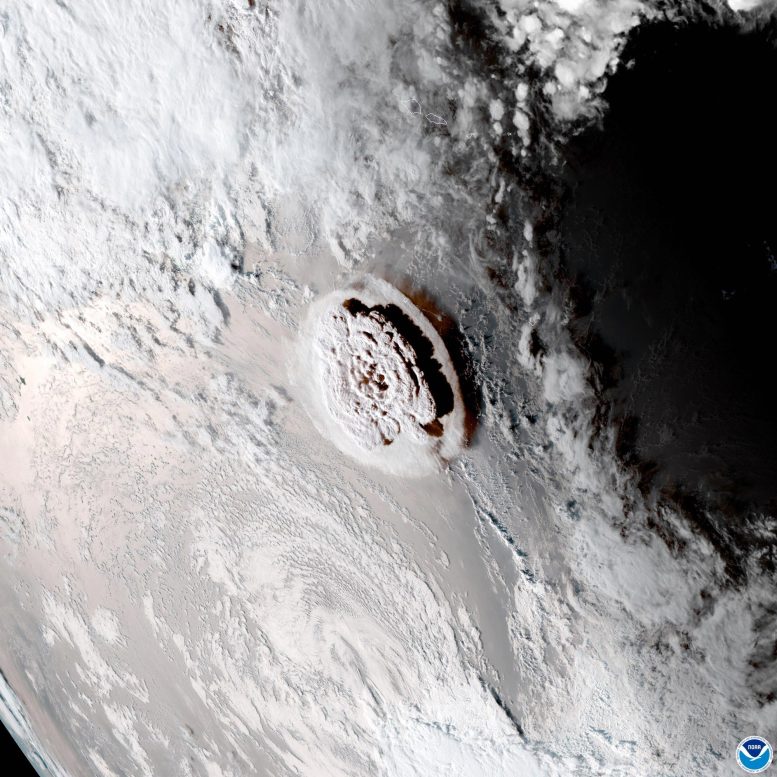
The Hunga eruption image is from the GOES-17 satellite of the National Oceanic and Atmospheric Administration. Credit: NOAA
Measurements of Lamb wave peak-to-peak pressure amplitudes as a function of distance indicated that the atmospheric pressure pulse generated by the Hunga event is comparable to that of the 1883 Krakatoa eruption. The Hunga signal amplitudes are over an order of magnitude larger than those generated by the 1980 Mount St. Helens eruption.
During the 1950s to 1960s atmospheric nuclear testing era, theoretical and empirical relationships were generated relating AGW amplitudes and periods to explosive yield.
“We find that such relationships are inapplicable to the signals generated by Hunga, as they result in unphysically large equivalent yields,” Kim said. “This difference is presumably because, for a given energy release, the long-duration climactic eruption excites longer-period pressure disturbances than the near-instantaneous nuclear reaction. Hunga signals have peak-to-peak pressures comparable to those produced by the largest historical atmospheric nuclear test (55 mt) but the dominant eruption signal periods are approximately four times longer than those of the nuclear explosion.”
For more on this study, see Hunga Volcano Eruption Created an Atmospheric Pulse That Caused an Unusual Tsunami-Like Disturbance.
Reference: “Atmospheric waves and global seismoacoustic observations of the January 2022 Hunga eruption, Tonga” by Robin S. Matoza, David Fee, Jelle D. Assink, Alexandra M. Iezzi, David N. Green, Keehoon Kim, Liam Toney, Thomas Lecocq, Siddharth Krishnamoorthy, Jean-Marie Lalande, Kiwamu Nishida, Kent L. Gee, Matthew M. Haney, Hugo D. Ortiz, Quentin Brissaud, Léo Martire, Lucie Rolland, Panagiotis Vergados, Alexandra Nippress, Junghyun Park, Shahar Shani-Kadmiel, Alex Witsil, Stephen Arrowsmith, Corentin Caudron, Shingo Watada, Anna B. Perttu, Benoit Taisne, Pierrick Mialle, Alexis Le Pichon, Julien Vergoz, Patrick Hupe, Philip S. Blom, Roger Waxler, Silvio De Angelis, Jonathan B. Snively, Adam T. Ringler, Robert E. Anthony, Arthur D. Jolly, Geoff Kilgour, Gil Averbuch, Maurizio Ripepe, Mie Ichihara, Alejandra Arciniega-Ceballos, Elvira Astafyeva, Lars Ceranna, Sandrine Cevuard, Il-Young Che, Rodrigo De Negri, Carl W. Ebeling, Läslo G. Evers, Luis E. Franco-Marin, Thomas B. Gabrielson, Katrin Hafner, R. Giles Harrison, Attila Komjathy, Giorgio Lacanna, John Lyons, Kenneth A. Macpherson, Emanuele Marchetti, Kathleen F. McKee, Robert J. Mellors, Gerardo Mendo-Pérez, T. Dylan Mikesell, Edhah Munaibari, Mayra Oyola-Merced, Iseul Park, Christoph Pilger, Cristina Ramos, Mario C. Ruiz, Roberto Sabatini, Hans F. Schwaiger, Dorianne Tailpied, Carrick Talmadge, Jérôme Vidot, Jeremy Webster and David C. Wilson, 12 May 2022, Science.
DOI: 10.1126/science.abo7063
Other collaborators include University of California, Santa Barbara; University of Alaska; Royal Netherlands Meteorological Institute; AWE; Royal Observatory of Belgium; NASA Jet Propulsion Laboratory; Université de Toulouse; University of Tokyo; Brigham Young University; U.S. Geological Survey; NORSAR, Kjeller, Norway; Université Côte d’Azur; Southern Methodist University; Laboratoire G-Time; Nanyang Technological University; Massey University, Palmerston North; Nuclear-Test-Ban Treaty Organisation; CEA, DAM, DIF, F-91297, France; BGR (Federal Institute for Geosciences and Natural Resources), Germany; Los Alamos National Laboratory; University of Mississippi; University of Liverpool; Embry-Riddle Aeronautical University; Wairakei Research Centre; University of Florence; Universidad Nacional Autónoma de México; Université de Paris, Institut de Physique du Globe de Paris; Vanuatu Meteorology and Geohazards Department; Korea Institute of Geoscience and Mineral Resources; Scripps Institution of Oceanography, University of California, San Diego; Volcanological Observatory of the Southern Andes, National Geology and Mining Service (OVDAS, Sernageomin); Penn State University; Incorporated Research Institutions for Seismology; University of Reading; NASA Goddard Space Flight; Norwegian Geotechnical Institute; and Instituto Geofísico, Escuela Politécnica Nacional, Ecuador.
The LLNL portion of the work was funded by the National Nuclear Security Administration’s Office of Defense Nuclear Nonproliferation Research and Development.







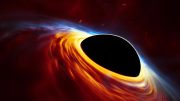

As I remember, Krakatoa caused a cold snap. Still waiting. You guys do not even try anymore. Its just about the headlines and clicks now. Very disappointed.